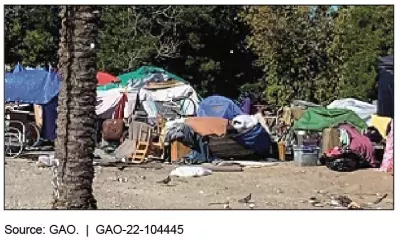The Challenges in Counting and Serving Homeless Populations
The days are getting colder as Thanksgiving approaches. Many of us may feel fortunate to share time and a meal with friends and family. However, during the holiday season and throughout the year, some people are living without shelter and are going hungry.
The federal government has a number of programs aimed at ending and preventing homelessness in America. Today’s WatchBlog post explores our recent work on two of these efforts—including the difficulties in counting homeless populations and in serving homeless youth.
Example of Homeless Encampment in Oakland, CA
Image

Challenges in accurately counting the homeless population
Gaining an accurate understanding of the scope of an issue is often the first step in addressing it. However, developing an accurate understanding of the extent of homelessness is challenging. For example, it is extremely difficult to count people living in cars, abandoned buildings, and other deserted places, and some of the homeless population may not wish to be found.
The Department of Housing and Urban Development (HUD) estimates U.S. homelessness levels through a count of people experiencing homelessness on a single night. This count is called the Point-in-Time (PIT) count. HUD requires local community organizations to carry out these counts on a single night in January.
To conduct the PIT count, communities must use one of HUD’s approved methods, which generally involve having volunteers or staff visually locate and attempt to survey unsheltered individuals on the street. Additionally, these in-person counts can be supplemented with administrative data, such as records collected by public and nonprofit agencies that may provide services to individuals experiencing homelessness.
In 2021, COVID-19 disrupted the PIT count. Due to health and safety concerns, HUD relaxed its data standards and permitted community organizations to use alternative approaches or even opt out of the count entirely. And because of the pandemic, some communities relied on administrative data in lieu of using in-person counts. In our report released yesterday, we recommended that HUD provide communities more information about how best to use such administrative data to improve PIT counts moving forward.
Challenges in serving youth who are homeless
Youth homelessness is a widespread problem in the United States. One recent study estimated that one in 10 young adults (ages 18 to 25) and one in 30 minors (under 18) experienced some form of homelessness without a parent or caregiver over the course of a year. This includes experiences such as living on the streets, in a shelter, or temporarily staying with others. Rates of homelessness are higher among youth of color and among lesbian, gay, bisexual, and transgender (LGBT) youth.
In September, we reported on several challenges nonprofits and other groups face in their efforts to serve youth who are experiencing homelessness. For example:
- Many providers of homelessness services told us that their community’s process for prioritizing people for housing resources tends to prioritize young adults lower than older adults.
- Several providers noted that there are limited housing options that can serve minors, and some providers and other stakeholders discussed challenges coordinating between the homelessness and child welfare systems.
- Providers also reported challenges in coordination and communication across their organizations, including a lack of understanding of one another’s programs and a need for strategic planning on services for youth.
Recognizing these challenges, we made recommendations for federal agencies to provide additional support for communities. These could include providing information on youth specific prioritization processes and sharing examples of how local communities are addressing the needs of youth and minors. This support could help to improve coordination and the delivery of services to both young adults and minors at the local level.
Find out more about our work on homelessness by checking out our key issue page on this topic.
- Comments on GAO’s WatchBlog? Contact blog@gao.gov
GAO Contacts
Related Products

GAO's mission is to provide Congress with fact-based, nonpartisan information that can help improve federal government performance and ensure accountability for the benefit of the American people. GAO launched its WatchBlog in January, 2014, as part of its continuing effort to reach its audiences—Congress and the American people—where they are currently looking for information.
The blog format allows GAO to provide a little more context about its work than it can offer on its other social media platforms. Posts will tie GAO work to current events and the news; show how GAO’s work is affecting agencies or legislation; highlight reports, testimonies, and issue areas where GAO does work; and provide information about GAO itself, among other things.
Please send any feedback on GAO's WatchBlog to blog@gao.gov.




